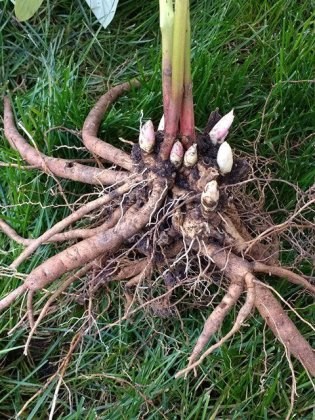There are over 30 species of peonies (Paeonia spp.) worldwide. Unfortunately, only a few of these are commercially available and ever show up in our gardens. Used medicinally in China and Europe for a wide range of ailments for centuries, peonies have been hybridized for thousands of years.
Herbaceous peonies (Paeonia lactiflora), also called garden peonies and Chinese peonies, are native to China and Japan. The species name, lactiflora means with milky flowers. First imported into England from China in 1805, this species is the source of thousands of our hybrids. About 60 cm (2 ft) in height, the stems carry two or more fragrant flowers. They have been a standard in prairie gardens for over a century because of their cold hardiness, drought tolerance, longevity and showiness. Paeonia officionalis is native to Eastern Europe and has also contributed to our garden peonies.
Herbaceous peonies consist of a tuberous root ball, crown and stems, with plants varying in height from 30 to 90 cm (1-3 ft). They bloom from late spring to early summer. Colours include white, pink, red to magenta, and yellow.
Fragrance varies among the varieties. Some of the older double varieties such as 'Festiva Maxima', 'Sarah Bernhardt' and 'Karl Rosenfield' are exceptionally fragrant.
The glossy, much-divided foliage is attractive throughout the growing season. It emerges with pink to purple tones, is green through the growing season, and generally colours again in the fall. The degree of leaflet division varies with the species and variety. Most will take up to five years to assume their mature flower characteristics.
Remember the mature size of a mature peony root ball and prepare the soil well. Planting holes should be a minimum of 45 cm deep by 60 cm (1.5 x 2.0 ft) in diameter. Space them 1 m (3 ft) apart from each other and other plants. Place them in full sun well away from tree roots in well-drained soil that has been generously amended with well-rotted organic matter such as manure or compost. There should be no more than 5 cm (2 in.) of soil above the top of the buds or "eyes".
Water deeply after planting (remember the depth of that root system!) and ensure even moisture for the first several years after planting. Once established, peonies are very drought tolerant. Side-dress with a light application of a high phosphorus fertilizer in early spring.
The older, double forms sometimes lack sturdiness because of their heavy flowers and relatively weak stems. These will require peony hoops or another form of support to remain upright, especially after heavy rain or wind.
Deadhead them after flowering, so the plant's energy will go into their roots rather than seeds. Buds for next year's stems are formed in the fall before the foliage dies.
Ants are neither helpful nor harmful to the peony. They are simply after a "free lunch" in the form of the exuded sugars on the flower buds. Botrytis, a fungal disease, can be a problem in some years. Water the soil rather than the foliage and increase air circulation. Remove and destroy infected foliage. Deer generally leave peonies alone.
They are well placed in the perennial border and are excellent in fresh or dried arrangements. Peonies can be left undisturbed for years. They are best propagated by division in September or early October. Lift the entire clump. The buds, stems and roots will be very brittle. Before dividing it, let it sit in the sun for a couple of hours to become less brittle and more flexible. Use a sharp knife. Each division should include a section of the root and crown with three to five stem buds or "eyes." When replanting, ensure that the tops of the buds are never more than two inches below soil level.
Peony flowers are self-fertile. Species may be raised from seed but may take up to five years to flower. The seed is large and dark blue to black.
Next week: Part II, Peony varieties.
Sara Williams is the author of many books including Gardening Naturally with Hugh Skinner, Creating the Prairie Xeriscape, and with Bob Bors, Growing Fruit in Northern Gardens. She gives workshops on a wide range of gardening topics throughout the prairies.
This column is provided courtesy of the Saskatchewan Perennial Society (SPS; [email protected]). Check our website (www.saskperennial.ca) or Facebook page (www.facebook.com/saskperennial) for a list of upcoming gardening events.
SASKTODAY.ca is Saskatchewan's home page. Bookmark us at this link.




